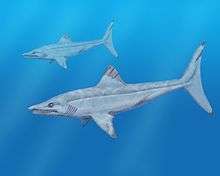Caseodus
Caseodus is an extinct genus of eugeneodontid holocephalian from the Carboniferous of the United States (Illinois, Indiana, Kansas, South Dakota) and the Early Triassic of Canada (British Columbia).[2] It was of medium size, measuring 1–1.5 m (3.3–4.9 ft) in length.[3][4][5]
| Caseodus | |
|---|---|
 | |
| Scientific classification | |
| Kingdom: | Animalia |
| Phylum: | Chordata |
| Class: | Chondrichthyes |
| Order: | †Eugeneodontida |
| Family: | †Caseodontidae |
| Genus: | †Caseodus Zangerl, 1981 |
| Species[1] | |
| |
Eugeneodontida are an extinct order of Chondrichthyes. They are characterized by the presence of tooth whorls. They include iconic genera, such as Helicoprion ("buzz-saw shark"), Ornithoprion, Edestus or Fadenia. Caseodus is one of the few eugeneodontid genera that survived the end-Permian mass extinction event. It is one of the last surviving genera of this clade
References
- Cimimurri, D.J; Fahrenbach, M.D. (2002). "Chondrichthyes from the upper part of the Minnelusa Formation (Middle Pennsylvanian: Desmoinesian), Meade County, South Dakota" (PDF). Proceedings of the South Dakota Academy of Science. 81.
- http://fossilworks.org/?a=taxonInfo&taxon_no=34456
- Lionel Calvin, Allison (2008) Fishes and the breakup of Pangea p. 12
- Mutter R.J., Neuman A.G. (2008): New eugeneodontid sharks from the Lower Triassic Sulphur Mountain Formation of Western Canada. In: Fishes and the Break-up of Pangaea Cavin L, Longbottom A, Richter M, editors. Geol Soc London Spec Publ 295: 941
- http://fossilworks.org/?a=taxonInfo&taxon_no=34456
- Froese, Rainer and Pauly, Daniel, eds. (2008). Species of Caseodus in FishBase. October 2008 version.
This article is issued from Wikipedia. The text is licensed under Creative Commons - Attribution - Sharealike. Additional terms may apply for the media files.